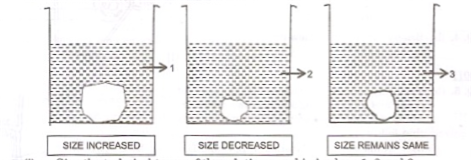ICSE biology
Sponsor Area
Differentiate between the following pairs on the basis of what is mentioned within brackets:
Turgor pressure and wall pressure (Explain)
| Turgor pressure | Wall Pressure |
|
Turgor pressure is the pressure applied by the cell content on the cell membrane when cell is turgid. |
Wall pressure – is the pressure applied by the cell membrane on the cell content. |
Sponsor Area
A candidate in order to study the process of osmosis has taken 3 potato cubes and put them in 3 different beakers containing 3 different solutions. After 24 hours, in the first beaker the potato cube increased in size, in the second beaker the potato cube decresed in size and in the third beaker there was no change in the size of the potato cube. The following diagram shows the result of the same experiment:
i. Give the technical terms of the solution used in beaker 1 2 and 3
ii. In beaker 3 the size of the potato cube remains the same. Explain the reason in brief
iii. Write the specific feature of the cell sap of root hair a which helps in absorption of water.
iv. What is osmosis?
v. How does a cell wall and a cell membrane differ in their permeability?
i. The technical terms of the solution used in beaker 1 2 and 3
1. Hypotonic
2. Hypertonic
3. Isotonic
ii. The third beaker contains isotonic solution, that is the concentration of the solution is the same as that of the potato cube, Thus, there is no osmosis taking place as there is no concentration gradient. Thus, the cube remains the same as no water is taken or released.
iii. Cell sap is present at a higher concentration that that of the surrounding soil and thus it absorbs water through the process of osmosis.
iv. Osmosis – Is the process of the movement of the solvent molecule from the region of its higher concentration to the region of its lower concentration through a semi-permeable membrane.
v. Cell wall is freely permeable while cell membrane is semi-permeable.
Chose the correct answer from the options given below:
After mitotic cell division , a female human cell will have:
-
44 + xx Chromosome
-
44 + xy chromosomes
-
22 + x chromosome
-
22 + y chromosome
C.
22 + x chromosome
a. Differentiate between the following pairs on the basis of what is mentioned within brackets:
Turgor pressure and wall pressure (Explain)
Turgor pressure is the pressure applied by the cell content on the cell membrane when cell is turgid
Wall pressure – is the pressure applied by the cell membrane on the cell content.
A candidate in order to study the process of osmosis has taken 3 potato cubes and put them in 3 different beakers containing 3 different solutions. After 24 hours, in the first beaker the potato cube increased in size, in the second beaker the potato cube decresed in size and in the third beaker there was no change in the size of the potato cube. The following diagram shows the result of the same experiment:
i. Give the technical terms of the solution used in beaker 1, 2 and 3.
ii. In beaker 3 the size of the potato cube remains the same. Explain the reason in brief
iii. Write the specific feature of the cell sap of root hair a which helps in absorption of water.
iv. What is osmosis?
v. How does a cell wall and a cell membrane differ in their permeability?
i. The technical terms are ;
1. Hypotonic
2. Hypertonic
3. Isotonic
ii. The third beaker contains isotonic solution that is the concentration of the solution is the same as that of the potato cube, Thus, there is no osmosis taking place as there is no concentration gradient. Thus the cube remains the same as no water is taken or released.
iii. Cell sap is present at a higher concentration that that of the surrounding soil and thus it absorbs water through the process of osmosis.
iv. Osmosis – Is the process of the movement of the solvent molecule from the region of its higher concentration to the region of its lower concentration. Through a semi-permeable membrane.
v. Cell wall is freely permeable while cell membrane is semi-permeable
Sponsor Area
Mock Test Series
Mock Test Series





